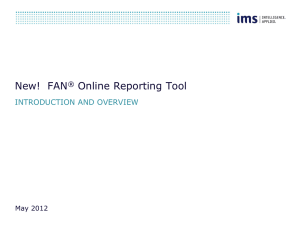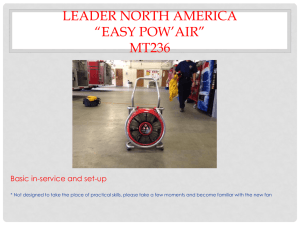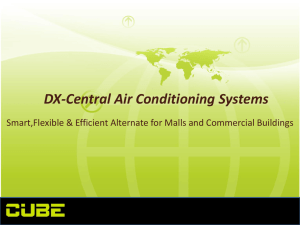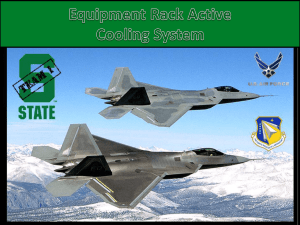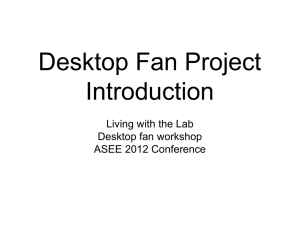Draft ACM Presentation - CBECC
advertisement
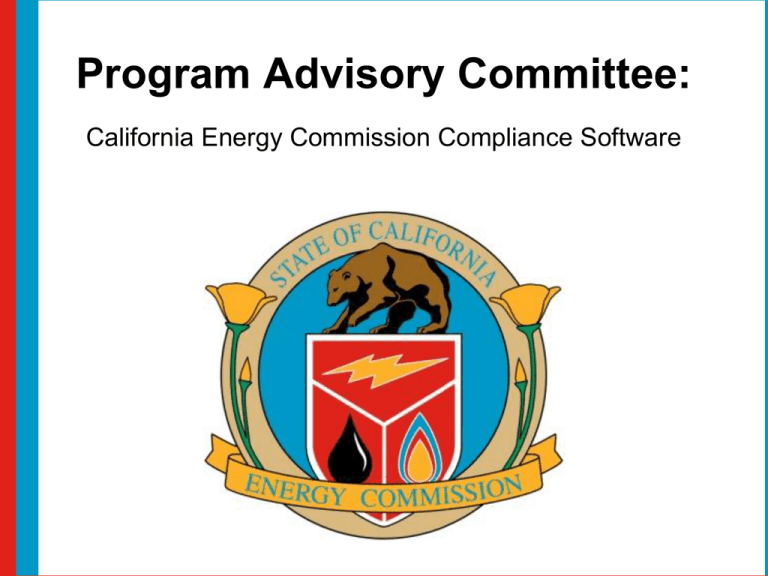
Program Advisory Committee: California Energy Commission Compliance Software 2013 Title 24 Nonresidential ACM Overview John Arent Architectural Energy Corporation ACM Manual Summary • Overview of Changes o Guiding Principles for ACM Revisions o Structural Changes to the ACM o Review of Key Changes o Review of New Modeling Requirements • ACM Compliance Ruleset Summary • Reference Method ACM Manual Summary • Guiding Principles for ACM Revisions o Retain consistency with Prescriptive Standards o Modify rules to be simulation agnostic Remove DOE-2 specific algorithms Remove external calculations where possible o o Incorporate new measures Provide a more stable baseline (similar to Appendix G) to move towards a performance-based standard ACM used as basis for both compliance and beyondcode programs Provide compliance credit for high-performance designs ACM Manual Summary • Structural Changes to ACM o Separated regulatory portion from technical portion o Technical portion is approved but not adopted Leaves possibility of bug fixes, updates within code cycle o Reorganized manual Based on COMNET Modeling Guidelines Baseline rule and proposed input for every building descriptor is explicitly called out New sections added for new modeling features (evaporative cooling, single zone VAV) ACM Manual Structural Changes • Each input from the user made separate building descriptor o o User input may be input directly to simulation, or may require processing Baseline rules and proposed input restrictions clearly specified Building Descriptors • Building descriptor set is translated by software to native simulation input (BDL or IDF) o Some building descriptors are directly translated to simulation input, or with minimal processing Cooling Efficiency o Some building descriptors affect the baseline building rules for a number of inputs Control System Type (DDC to the zone level) o Some building descriptors modify other inputs Refrigerant Charge Factor o The ACM inputs should correspond to data that is readily obtainable by the MEP engineer 2013 Nonres ACM Manual Structure Chapter 1. Overview Chapter 2. General Modeling Procedures Chapter 3. Software Requirements Chapter 4. Compliance Reports Chapter 5. Building Descriptor Reference Focus on Chapters 2 and 5 Reference Method (Chap. 3) covered later ACM Manual Summary • Chapter 2: Thermal Blocks and Zone Layout o Clarified conditions in which zones can be combined Same space temperature setpoint Operating schedules vary by no more than 40 full load equivalent operating hours (FLEOH) o Define daylit zones within the space for baseline Proposed building specifies Watts in daylit zone Chapter 2: System Sizing • Review of Key Changes: HVAC Sizing o Revised sizing method based on Unmet Load Hours Cannot exceed 300 in proposed or baseline o o o o Follows ASHRAE 90.1-2010 Appendix G Baseline auto-resized if UMLH exceed 300 Allow use of local design day conditions for proposed sizing May require iterative runs if baseline is undersized Sizing Procedure (based on 90.1) Chapter 3: Software Requirements • Reference Method tests based on EnergyPlus o Test a greater range of building systems and features • ASHRAE 140-2007 tests required to verify basic modeling features (not part of Reference Method) • Qualitative Tests ensure that the baseline is properly specified • Quantitative Tests ensure that the simulation predicts absolute energy use and compliance margin to within a specified tolerance • Prototype buildings based on 90.1 Prototypes, developed by PNNL Chapter 4: Standard Reports • Compliance Forms revised, details to be determined Chapter 5: Building Descriptors Reference • Contains bulk of rule information 5.1 Overview 5.2 Project Data 5.3 Thermal Blocks 5.4 Space Uses 5.5 Building Envelope 5.6 HVAC Zone Level Systems 5.7 HVAC Secondary Systems 5.8 HVAC Primary Systems 5.9 Miscellaneous Energy Uses Section 5.2: Project Data • Building Classification: sets the whole building activity type for: o o o Space Use classifications Prescriptive Lighting Levels Schedules – building classification mapped to 1 of 11 • Climate Data: revised so that weather extremes coincide with TDV peaks Chapter 5.3: Thermal Blocks • New Infiltration Model • (1) • where: Infiltration = zone infiltration airflow (m³/s-m²) Idesign = design zone infiltration airflow (m³/s-m²) Fschedule = fractional adjustment from a user input schedule (unitless) tzone = zone air temperature (°C) todb = outdoor dry bulb temperature (°C) ws = the windspeed (m/s) A = overall coefficient (unitless) B = temperature coefficient (1/°C) C = windspeed coefficient (s/m) D = windspeed squared coefficient (s²/m²) Infiltration Schedule: Set to 1 when fans are off and 0.25 when fans are on Chapter 5.3: Thermal Blocks • Furniture and Contents o o remove detailed spec of interior mass Set baseline to same as proposed • Removed: FURNITURE-TYPE = HEAVY FURN-WEIGHT = 80 FURN-FRACTION = 0.85 Chapter 5.4.3: Interior Lighting • Review of Key Changes: Lighting o New Space categories for space-by-space method o Added Light Heat Gain to space from ASHRAE HOF o Revised PAF table o Removed custom schedules as an adjustment credit o Area Category: Separated General Lighting Power from Custom Lighting Power into two explicit building descriptors Allowance type determines custom LPD baseline o Tailored Lighting Approach Added Tailored Lighting Mounting Height input for calculating room cavity ratio and tailored allowance Interior Lighting Heat Gain • Specifies fraction of heat gain to space and radiative fraction Source: 2009 ASHRAE HOF, Chapter 18, Table 3 Example: Recessed fluorescent luminaire with lens: Space Fraction: 0.40. to 0.50 (default 0.45) Radiative Fraction: 0.61 to 0.73 (default 0.67) Chapter 5.4.3: Daylighting o Modified Daylighting Method – adjustment factors for split-flux method Based on comparison of split flux results with Radiance Adjusts fc estimate in primary and secondary daylit zone o o Reference Position – based on one window head height for primary daylit zone and two head heights for secondary daylit zone Illuminance Setpoint – possible change from equation that is based on LPD to a fixed fc by space type (table lookup) 5.4.5 – 5.4.7: Plug Loads and Refrigeration • Internal Load Modeling o Appendix 5.4 has internal load data by space type o Refrigeration Modeling Options: (1) Refrigeration Power Density (2) DOE model for packaged equipment (kWh/day) (3) Model refrigeration COP and condenser location (interior/remote) (4) Detailed Refrigeration Model not used – no prescriptive requirements for refrigeration Not used for compliance credit; but used for percent savings calculations o Model elevator load with schedule as neutral load Chapter 5.4.8: Gas Equipment Use • • • Gas Equipment Power: (Btu/h-ft2) from Appendix 5.4A Gas Equipment Schedule: continuous operation Gas Equipment Location: in the space, external Baseline Same as Proposed • Radiation Factor Default is 0.15 Values from ASHRAE HOF for different kitchen appliances See 2009 HOF Chapter 18, Table 5C for details Appendix 5.4: Whole Building Space Uses Appendix 5.4: Area Category Space Uses (Partial Table) Prescribed: Occupant Density, Occupant Heat Gain, Ventilation Rate Default: Occupant Schedule, Fan Schedule, Heating/Cooling Schedule ACM Schedules • Review of Key Changes: System Schedules o o o o Adopting 10 of ASHRAE 90.1-2010 Occupancies (Schedules), and adding a Schedule for Data Centers Follows ASHRAE 90.1-2010 User Manual Assembly, Data Center, Health, Light Manufacturing, Office, Parking, Restaurant, Retail, School, Warehouse, Laboratory Each Schedule Set includes: Occupant Schedule Lighting Schedule Equipment Schedule HVAC Operation Schedule Cooling, Heating Setpoint Schedule Elevator Schedule ACM Schedule Example: School 100 School Occupancy 90 80 70 60 WD 50 Sat 40 Sun 30 20 10 0 1 2 3 4 5 6 7 8 9 10 11 12 13 14 15 16 17 18 19 20 21 22 23 24 Lights Schedule 70 Light Sch (%) 60 50 40 WD Sat 30 Sun 20 10 0 1 2 3 4 5 6 7 8 9 10 11 12 13 14 15 16 17 18 19 20 21 22 23 24 Chapter 5.5: Envelope • Review of Key Changes: Envelope o Specify layers for opaque assemblies Provide Appendix of Layers that includes composite layers (framing + insulation) o Specify one baseline for opaque envelope Steel-framed walls, steel-joist floors, metal building roofs o One Fenestration Requirement for all Climate Zones New VT Requirement o Cool Roof Requirement increased in stringency Overall Envelope TDV Approach for alterations Chapter 5.5: Envelope (cont.) • Specify simple method for slab-on-grade constructions o F-factor corresponding to table in JA4 • Specify C-factor values for below-grade assemblies • Interior blind control under review • Added new inputs for dynamic glazing: o o o o SHGC Dim Fraction – the fraction of full light SHGC when the window is dimmed to the low setting VT Dim Fraction – the fraction of the full VT when the window is dimmed to the low setting Switchable Threshold Switchable Dimming Schedule Slab-on-grade Heat Transfer 2008 ACM: 1) Insulation level determines coefficients for bi-weekly, monthly and annual components of each transfer 2) Core and heat transfer calculated separately 3) Weighted average of bi-weekly, monthly and annual outside air temperatures used for ground temp Slab-on-grade Heat Transfer 2013 ACM: 1) F-factor selected from Appendix JA4 2) Simulation model uses built-in algorithm or external calculation 3) Reference Method test verifies software procedure yields acceptable results Chapter 5.6: Zone Level Systems • Control System Type o DDC or other – affects baseline for some control input • Space Thermostat Throttling Range – default is 2°F o EnergyPlus has tolerance but not the throttling range concept • Added Baseboard Systems o Baseboard Capacity, Baseboard Heat Control inputs • Terminal Heating Control Type o o Dual Maximum with “temperature first” reset for DDC control systems Single Maximum for other systems Section 5.6: Zone Level Systems • Dual Maximum Control for Systems with DDC to the zone level • Specific Reset Sequence: o o Reset SAT up to 95F with airflow at minimum (20%) Reset airflow up to heating max as heating load increases Chapter 5, 5.7: 2013 System Map Based on ASHRAE 90.1-2010 App. G, with some modifications for California Building Type Residential Nonresidential and 3 Floors or Less than <25,000 ft2 Nonresidential and 4 or 5 Floors and <25,000 ft2 or 5 Floors or Less and 25,000 ft2 to 150,000 ft2 Nonresidential and More than 5 Floors or >150,000 ft2 Nonresidential and 3 Floors or Less and less than 25,000 ft2 and zone cooling load >= 110,000 Btu/h* Heated Only Storage Total computer room design cooling load is over 3,000,000 Btu/h or the non-computer loads are served by System Types 5 or 6 Computer rooms that do not meet the conditions for System 10, CRAH Fossil Fuel, Fossil/Hybrid, Purchased Heat System 1 - PTAC System 3 – PSZ AC Electric and Other System 2 - PTHP System 3 – PSZ AC* or System 5 – PVAV with Reheat System 4 – PSZ HP System 5 System 6 – VAV with reheat System 6 System 7 – Single Zone VAV System 7 – Single Zone VAV* or System 8 – Single Zone VAV HP System 9 – Heating and Ventilation System 10 – CRAH Units N/A N/A System 11 – CRAC Units N/A * Gas baseline (System 3 or 7) if natural gas is available at site 2013 System Map (cont.) System No. System Type Fan Control Cooling Type 1 – PTAC Package terminal Constant volume DX air conditioner 2 – PTHP Package terminal Constant volume DX heat pump 3 – PSZ AC Package single Constant volume DX zone 4 – PSZ HP Package single Constant volume DX zone heat pump 5 – PVAV reheat Package VAV Variable volume DX reheat 6 – VAV reheat VAV reheat Variable volume Chilled water 7 – SZVAV Single Zone VAV Two-Speed* DX 8 – SZVAV HP Single Zone VAV Two-Speed* DX HP 9 – Heating Heating only Constant volume None ventilation 10 – CRAH CR Air Handler Variable volume Chilled Units water 11 – CRAC CR Air Variable volume DX Units Conditioner Heating Type Hot water fossil fuel boiler Electric Heat Pump Fossil fuel furnace Electric Heat Pump Hot water fossil fuel boiler Hot water fossil fuel boiler Fossil fuel furnace Electric Heat Pump Gas furnace N/A N/A 2008 ACM System Map • Review of Key Changes: HVAC System Map 5.7.2 System Control • Cooling Supply Air Temperature Control o Added Staged Setpoint for multi-stage systems (single zone VAV) • Cooling Reset by OSA – added specific curve as default only 65 64 63 SAT Setpoint 62 61 60 59 58 57 56 55 0 20 40 60 OAT 80 100 120 Section 5.7.3: Fan Systems • Fan System Modeling Method o Power-per-unit-flow, brake horsepower, static pressure • Specify Supply Fan Ratio, Return Fan Ratio, Exhaust Fan Ratio o • Maintain same proportion of fan power for each fan type in baseline as proposed Software that require input of static pressure and eff: o o o o Calculate supply fan ratio, return fan ratio, exhaust fan ratio for proposed Specify motor efficiency for each fan from Standard Determine capacity (CFM) for each fan system Calculate equivalent static pressure for baseline fans Section 5.7.3: Fan Systems • Adopt ASHRAE 90.1 Fan Power Adjustments for Special filtration, and other design requirements • 2008 ACM allowed extra static pressure only for systems with design pressure drop in excess of 1” w.g. • See 90.1-2010 Table 6.5.3.1.1B for details • Example: MERV 13 filter receives 0.9” w.c. Brake Horspower Adjustment: A = S (PD × CFMD/4131) where PD = each applicable pressure drop adjustment from Table 6.5.3.1.1B in in. w.c. CFMD = the design airflow through each applicable device from Table 6.5.3.1.1B in cubic feet per minute Section 5.7.3: Fan Systems (cont.) • Fan System Modeling Methods – includes all fans that operate at design conditions (1) (2) (3) • Specify Supply Fan Ratio, Return Fan Ratio, Exhaust Fan Ratio o • Power-per-unit-flow – W/cfm for the fan system Brake horsepower – requires brake horsepower and motor efficiency Static pressure – requires, Static pressure, Fan (Static) Efficiency, Motor Efficiency. This option requires plan check. Baseline System has same proportion of supply fan bhp, return fan bhp, and exhaust fan bhp as proposed Fan Part-Load Curves: added curve for VSD with Static Pressure Reset Section 5.7.3: Garage Exhaust • Garage Fan exhaust included as regulated load • Small Fan Systems (<10,000 cfm) – baseline of 0.35 W/cfm • Large Fan Systems (10,000 cfm and greater): (1) (2) (3) Baseline set at 0.044 W/cfm Modeled as Constant Volume – lower fan power approximates effect of CO Control No Compliance Credit – modeled as fixed value since this is a mandatory measure Section 5.7.4: Economizers • Economizer Control Type o Required now for 54,000 Btu/h and above • Economizer Integration Type o Separate building descriptor from control type • Economizer High Temperature Lockout: o o o o Climate Zone 7: dry-bulb high limit of 69°F Climate Zones 6, 8, 9: dry-bulb high limit of 71°F Climate Zones 2, 4, 10: dry-bulb high limit of 73°F Climate Zones 1, 3,5,11-16: dry-bulb high limit of 75°F Section 5.7.5: Cooling Systems • Coil Bypass Factor o o Coil Bypass Factor and Bypass Factor Adjustment Curve – used in DOE-2 only. EnergyPlus uses a different coil model and latent heat transfer. EnergyPlus – uses Sensible Heat Ratio (Total and Sensible Cooling Capacity at rated conditions) • New rules for multi-stage packaged DX equipment • New equipment types covered: o o o Evaporative Cooling – new credit for systems that meet the Western Cooling Challenge Evaporative Condenser Desiccant Systems Western Cooling Challenge WCC Test Result is a single EER performance metric. Systems that meet WCC criteria modeled as DX with high EER Systems that do not qualify for WCC can still be modeled by the native evaporative cooling software capabilities. Section 5.7.5: Single Zone VAV • Multi-stage DX – meet single zone VAV requirement • Typical System has two or more compressors and a twospeed or variable speed fan • Building descriptors: o o o o o o o o Number of Cooling Stages – 1 to 4 Total Cooling Capacity by stage – array of fractional capacities Sensible Cooling Capacity by stage – array of fractional capacities Supply Air Temperature Reset by stage – specifies supply air temperature reset amount from design SAT Number of Heating Stages Heating Capacity by Stage Supply Fan Low Speed Ratio Supply Fan Low Power Ratio Section 5.7.5: Duct Leakage • Removing external algorithms from ACM • Previous ACM has algorithm for duct leakage and heat loss to unconditioned space and outdoors • Propose specifying inputs, not algorithm o o o o o Duct leakage rate – value determined if sealing and testing done Duct Surface Area Duct Fraction Outdoors Duct Fraction Unconditioned space Duct Insulation Level • Provide Reference Method test to verify candidate software produces an acceptable result Laboratory Systems • VAV Air Handling Unit with 100% OA • Preheat coil and cooling coil • Constant volume exhaust modeled as plug load in unconditioned space • VAV zone controls to set minimum to match level mandated by AHJ Data Centers and Computer Rooms • New space type in Appendix 5.4 o o 80°F Cooling Setpoint, receptacle load as designed New Schedules for data center / computer room • New HVAC Systems: o o Computer Room Air Handler (CRAH) for larger cooling loads Computer Room Air Conditioner (CRAC) for smaller loads Data Centers and Computer Rooms • CRAH Unit Specification Data Centers and Computer Rooms • CRAC Unit Specification Section 5.7.5.3: Evaporative Cooling Evaporative Cooling • Direct Stage Effectiveness • Indirect Stage Effectiveness • Evaporative Cooling Performance Curve – function of flow • Auxiliary Evaporative Cooling Power – energy of pumps for cooling stages an indirect evaporative fan • Evaporative Cooling Scavenger Air Source – air source for indirect stage; can be return air or outside air Section 5.7.5.4: Evaporative Cooling Evaporative Pre-Cooling • Evaporative Condenser Power • Evaporative Condenser Effectiveness • Evaporative Condenser Operation Range – dry-bulb temperature range Section 5.7 – Performance Curves • Provide more complete set of curves • Provide software neutral curves where possible • Specify in Appendix (in progress): o o Curve Coefficients Performance map • ASHRAE SPC205 working on standardizing performance curves Section 5.7 – Performance Curves • Coil Bypass Factor o o o Specify fixed value – can impact performance Specify fixed performance curve Not applicable for EnergyPlus • Cooling Tower Capacity Specification o Work in progress to true up DOE-2 and E+ defaults 5.7.5.5 Radiant Cooling (chilled slab) • New modeling feature • Key Inputs: o o o o o Tubing length, diameter Control temperature Flow rate Pump Power and efficiency Interlock for condensation control • Constant and variable flow systems represented 5.7.6.5 Heat Pump heating • Coil defrost o o o o Hot-gas defrost, on-demand Hot-gas defrost, timed 3.5 minute cycle Electric resistance defrost, on-demand Baseline: Electric resistance defrost, timed 3.5 minute cycle • Coil defrost kW – for systems with electric resistance heat • Crankcase heater power o Defaults to 0 5.7.6.6 Heat Recovery • New modeling feature • Sensible heat recovery effectiveness • Latent heat recovery effectiveness HREFF EEAw ELAw EEAw OSAw • Condenser heat recovery effectiveness • Heat Recovery Use o Reheat coils or water heating 5.8.3 Cooling Towers • Cooling Tower Total Fan Horsepower o o o Specified as gpm/hp (2008 ACM uses EIR) Baseline References Standard 110.2 Cooling Tower Low-Speed Airflow Ratio – baseline changed from 0.33 to 0.50 • Approach Temperature o Work in progress on specifying part-load capacity in a generic format • Condenser water reset o o Fixed, or wet-bulb reset Default approach of 10°F 5.8.4 Waterside Economizers • Waterside Economizer Type o o o o HX In Parallel with Chiller (non-integrated) HX In Series Direct (strainer cycle) Thermo-cycle (refrigerant migration) • Other Inputs o o o o o HX Effectiveness Maximum DB Temp Maximum CW Supply Temp CWS Setpoint – defaults to 45°F Schedule, Auxiliary kW (pumps/other) 5.8.5 Central Plant Pump Specification • 2008: Specify design head, impeller efficiency, motor efficiency o No credit for reduced design head • New ACM: incorporate 90.1-2010 specification o 22 W/gpm Chilled Water o 19 W/gpm Condenser Water o 19 W/gpm Hot Water o Motor efficiency set from Standard and NEMA regulations as before 5.8 Central Plant Management • 2008 ACM: rule requires that a chiller or boiler be brought up to 90% capacity before staging on another • 2013 ACM: o Proposed Building: as designed Allows more flexibility for variable speed chillers o Baseline Building: same as proposed 5.8.6 Thermal Storage • Covers chilled water, ice storage but not stratified tanks • Building Descriptors: o o o o o o o Configuration: Series (Upstream,Downstream), Parallel Ice Storage Type: Internal or External Storage Capacity Tank Volume CHW Setpoint Schedule Deadband Temperature difference Minimum Temperature Limit – charging tank disabled 5.8.6 Thermal Storage • Building Descriptors (cont): o o o o o o o Minimum Temperature Limit – charging tank disabled below this temperature Storage Tank Location – Zone, or Exterior Storage Tank Heat Gain Coefficient – between tank and ambient Use Side Heat Transfer Effectiveness Use Side Design Flow Rate Source Side Heat Transfer Effectiveness Source Side Flow Rate 5.9 NAECA Covered Water Heaters • 2008 ACM: Losses specified through part-load performance curve o Custom Curve generated through inputs of standby loss, thermal efficiency and part load fraction • 2013 ACM: Specify tank loss coefficient as alternate method o DOE Test Procedure used to express UA loss coefficient as a function of Energy Factor and Thermal Efficiency 5.9.2 Exterior Lighting • Historically not modeled since no tradeoffs allowed • Simple inputs provided to record as regulated energy for beyond code programs • Key Inputs: o o o Exterior Lighting Power Exterior Lighting Control – photocell and time clock Exterior Lighting Schedule 5.9.3 – 5.9.4 Other Energy Uses • Swimming Pools – must meet mandatory measures and are not required to be modeled • Miscellaneous Electric Power – outside of the building envelope • Miscellaneous Gas Power – outside of the building envelope (i.e., snowmelt system) Other ACM Items in Progress • Daylighting Model o o Finish development of daylight adjustment factors Specify rules for Reference Position for Primary and Secondary Daylit Zone • Alterations – Complete Baseline Specification • Overall Envelope Tradeoff Specification o Primary Use is Roof Reflectance Tradeoff • Complete Performance Curve Specification • Compliance Forms
